Wayne C. Allen's Blog, page 29
December 27, 2016
There is no remedy – No Hay Remedio
Of Wayne’s many books, the one closest to today’s topic is: Half Asleep in the Buddha Hall
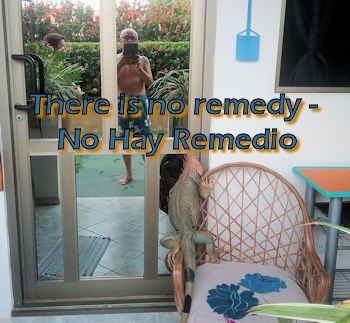
Well, here it is, finally–the last few days before we get to say a fervent goodbye to 2016. In the last few weeks, we’ve been on the road, shifting domiciles, etc. and are now in Canada. Leaving Costa Rica gets harder each time.
We will return to Costa Rica in April, and in the mean time have a chance to see friends and family here. I have a few paintings in my head that need to exit onto canvas through a brush, and some other stuff to edit.
Which brings me to mention that I’ve been working on a 2nd edition of This Endless Moment! I decided to give it a go back last May, and have edited the old book, and added about 60 or so pages of new materials and exercises. I’m thinking it will be available in February, but we shall see.
As to a closing point for 2016, I learned the expression no hay remedio recently, and thought it really did capture the essence of both Zen living and The Pathless Path. It can have a negative connotation, as in “Trapped in a mess,” but I’d like to propose and alternative.
We are as we are, and so is the world
It is our nature to obsess, to cling, to grasp, to lust, to hate. It is built into each of us to get caught in the trap of clinging on — even to things we detest. On and on we go, telling ourselves stories, making ourselves miserable.
As this is our nature, there is no remedio — no remedy — no cure.
But there is moment-by-moment choice to conduct ourselves differently. We can notice the games we are playing up there in the wilderness of our minds, and have a laugh, and then… conduct ourselves differently.
We can reach out when we want to pull in, let go when we want to grasp, stand next to when we want to push away. We can stop complaining and do things differently.
We can move, we can start a new career or job, we can retire early, we can become passionate about what was formerly a hobby. We can treat others with kindness and respect, even when the little kid in our heads is screaming “I don’t wanna.”
In short, the remedy for “no remedy,” is to get over ourselves, and then to act with elegance.

Darbella and I wish you an 2017 of focus, attention, awake-ness and caring!
div.wpob_template_main.wpob_template_main_1{display: none;}
.wpob_template_main_1{
background-color: #fff;
max-width: 750px;
height: 310px;
border-width: 7px;
border-color: #ccc;
margin-top: ;
margin-bottom: ;
margin-left: ;
margin-right: ;
}
.wpob_template_main_1 .wpob_box_heading{
background-color: #8f0a0b;
}
.wpob_template_main_1 .wpob_box_heading_text{
font-family: 'Shadows Into Light', serif;
font-size: 24px;
line-height: 40px;
color: #fff;
text-align: center;
text-transform: uppercase;
font-weight: 900;
margin: 0;
}
.wpob_template_main_1 .wpob_box_media_container{
display: inline-block;
width: 120px;
height: 164px;
}
.wpob_template_main_1 .wpob_box_content_container{
}
.wpob_template_main_1 input.wpob_input_fields{
width: 200px;
line-height: 36px;
margin-bottom: 5px;
border: 1px #ddd solid;
vertical-align: middle;
font-size: 16px;
color: #999;
font-size: Arial;
padding: 0px 8px;
}
.wpob_template_main_1 .wpob_box_image{
width: 100%;
height: 100%;
}
.wpob_template_main_1 .wpob_box_media_center{
display: block;
margin: 0 auto;
padding: 10px;
}
.wpob_template_main_1 .wpob_box_media_right{
float: right;
padding: 10px 0px 10px 20px;
}
.wpob_template_main_1 .wpob_box_media_left{
float: left;
padding: 10px 20px 10px 0px;
}
.wpob_template_main_1 .wpob_box_content{
font-family: Fjalla One;
font-size: 18px;
line-height: 24px;
color: #333;
text-align: center;
padding: 1em;
}
.wpob_template_main_1 .wpob_box_button_div{
text-align: center;
padding: 0em 1em 1em 1em;
}
.wpob_template_main_1 .wpob_box_button_div a.wpob_box_button, .wpob_template_main_1 .wpob_box_button_div button.wpob_box_button{
font-family: Georgia;
font-size: 18px;
color: #fff;
background-color: #0c8442;
border-radius: 5px;
width: ;
padding: 10px 15px;
}
.wpob_button_gradient{background-image : -moz-linear-gradient(top, #0c8442, #057538);background-image : -ms-linear-gradient(top, #0c8442, #057538);background-image : -webkit-gradient(linear, #0c8442, #057538);background-image : -webkit-linear-gradient(top, #0c8442, #057538);background-image : -o-linear-gradient(top, #0c8442, #057538);background-image : linear-gradient(top, #0c8442, #057538);filter : progid:DXImageTransform.Microsoft.gradient(startColorstr="#0c8442", endColorstr="#057538", GradientType=0);border-color : +#0c8442 #057538 #057538;background-color : #0c8442;}
A Shameless Bribe!!

Receive The Pathless Path by e-mail!
As a thank-you, we'll send you a link to our pdf booklet, Exercises in Consciousness.
What could be better than that??
Cick and Join Us!
The post There is no remedy – No Hay Remedio appeared first on The Pathless Path.
Original article: There is no remedy – No Hay Remedio. If you're reading this on another site, let me know...
December 11, 2016
The Finger That Points to the Moon…
Synopsis: The Finger That Points to the Moon… — our internal representations are neither real, nor necessarily correct.
Of Wayne’s many books, the one closest to today’s topic is: Half Asleep in the Buddha Hall
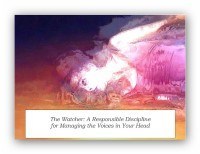
Some years ago, I wrote a booklet called The Watcher… it’s about dealing with depression and other annoying voices in our heads. I decided to expand it. The booklet is FREE! (Although you can also leave a donation… )
You can use the same plan included in The Watcher to work on any “voice in your head.”. Just click here — you’ll end up on The Phoenix Centre Press site
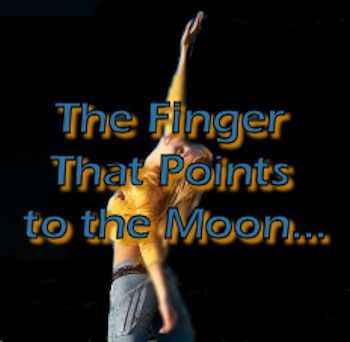
Conclusion to a Zen story:
“Truth has nothing to do with words. Truth can be likened to the bright moon in the sky. Words, in this case, can be likened to a finger. The finger can point to the moon’s location. However, the finger is not the moon. To look at the moon, it is necessary to gaze beyond the finger, right?”
Ah, those Zen masters. It’s painfully clear that much of what they discuss, usually in response to a question – is the unreality of what we call reality. Or better put, the unreality of our descriptions, beliefs, and stories.
A more modern way of putting this is that reality is subjective.
If you think about it, pretty much all the conflict in the world, now and forever, is a fight over whose picture of “whatever” is the correct one. This is so no matter how big or small the disagreement. It’s the basis for psychotherapy — the client’s version of the story isn’t working, so they head off to the wise therapist for a version correction.
As if the therapist’s version is any more correct.
Nonetheless, wisdom has a lot to do with letting go of stories and perceptions, and engaging directly with “the moon.” This is engagement unvarnished by long-winded defenses or explanations.
Yet, many are the people who will spend hours and hours arguing about the validity of their perceptions, despite the fact that the results they are getting from using those perceptions clearly and plainly suck.
I describe this as “whacking yourself in the head with your own mallet.”
A story occurred to me: some years ago, a client presented the following: his daughter wasn’t living her life the way he wanted her to, and after the last fight, they hadn’t spoken for months. He listed off what she was doing that he didn’t approve of, and said that, no matter how much he insisted, she kept doing them.
I responded, “All of the things you want your daughter to do are perfectly right. However, they’re appropriate for a 14-year-old. Your daughter is 31.”
He got this odd look on his face for a moment, then said, “Well, that probably isn’t going to work.”
Here’s the finger-pointing part: when he pictured his daughter in his mind, he saw a young woman perpetually in trouble, and perhaps more significant, perpetually 14. He was therefore locked into “dad of a delinquent 14-year-old mode.” His subsequent behaviour perfectly fit that role.
Thus, his “finger-pointing to the moon” was perfectly accurate within its own context (in his head.) It just wasn’t pointing to anything other than itself.
That’s really the point of the expression under consideration today. In a sense, it’s like raising your hand to (apparently) cup the moon and believing that you actually hold the moon in your hand. In other words, we act as if the representation we make in our minds, about pretty much anything, is the actual reality of the topic at “hand,” as opposed to an imagined representation.
Have you ever sat in one of those business meetings where everyone is “trying to reach consensus?” So, be honest. Aren’t you sitting there, and inside, thinking, “What the hell is the matter with these people? Why don’t the get this? My finger, pointing, is just so obviously the same as the moon! And they dare to challenge me with theirs?”
We waste inordinate amounts of time trying to get people to agree with our internal representations. Every time I hear someone say, “This is how it is,” I have a pretty good idea how it isn’t. If it were that way, there would be no need to explain it or try to convince anyone.
That’s really been the point of the problems with the 2106 election in the States. (And of course, this is my finger, pointing…) Little Donald’s angry tweets, for example, are provably “wrong” — have nothing to do with reality — and yet are agreed to by millions. Not as facts, but as “I just feel it and believe it — and now I’m going to stuff it down your throat.” And this is soon to be the basis for running a country.
It is simple arrogance that causes us to think that our opinion should be important to anyone other than ourselves.
One of the ways past this is to change our language. Rather than declare my “finger-pointings” — my opinions — as being true, I simply say, “Here is the story I am telling myself.” This acknowledges that everything I believe is an invention.
Reality, on the other hand (the moon) is “that with which I engage.” Reality is a 31-year-old daughter sitting across from her dad, and dad dropping the rant, and simply conversing. Not convincing, conversing.
As we explore our world-views with each other, the discussion ought not be about “right and wrong.” Our interpersonal disagreements are simply conflicting opinions. Rather, our discussion might turn to how we are going to “work” with each other: “How is this working for me, and how is yours working for you?”
If I am treating my 31-year-old like a 14-year-old and she doesn’t like it and isn’t talking to me, I can keep doing it in hopes that she sees the light and starts acting like a good 14-year-old, or I can ask myself how I like the results of my actions.
If my goal is to dominate my daughter and keep her under my thumb, I want to keep doing what I’m doing.
If I want to set up an adult-to-adult relationship with her, I’m going to have to change my behaviour at the least, and I would be wise to change my internal representation of her from 14 to 31.
In the end, it’s that “simple.”
What are your internal representations? Can you own them as your personal property — not something to be “sold” but “simply yours?”
Wisdom and “truth” is about getting over trying to manipulate others into to doing it your way, while resisting being manipulated into doing it their way. From there, you can check how well your representations are working for you, and look for ways to change the ineffective ones.
Representations are just that. The finger that points to the moon is not the moon. Simple, eh?
div.wpob_template_main.wpob_template_main_1{display: none;}
.wpob_template_main_1{
background-color: #fff;
max-width: 750px;
height: 310px;
border-width: 7px;
border-color: #ccc;
margin-top: ;
margin-bottom: ;
margin-left: ;
margin-right: ;
}
.wpob_template_main_1 .wpob_box_heading{
background-color: #8f0a0b;
}
.wpob_template_main_1 .wpob_box_heading_text{
font-family: 'Shadows Into Light', serif;
font-size: 24px;
line-height: 40px;
color: #fff;
text-align: center;
text-transform: uppercase;
font-weight: 900;
margin: 0;
}
.wpob_template_main_1 .wpob_box_media_container{
display: inline-block;
width: 120px;
height: 164px;
}
.wpob_template_main_1 .wpob_box_content_container{
}
.wpob_template_main_1 input.wpob_input_fields{
width: 200px;
line-height: 36px;
margin-bottom: 5px;
border: 1px #ddd solid;
vertical-align: middle;
font-size: 16px;
color: #999;
font-size: Arial;
padding: 0px 8px;
}
.wpob_template_main_1 .wpob_box_image{
width: 100%;
height: 100%;
}
.wpob_template_main_1 .wpob_box_media_center{
display: block;
margin: 0 auto;
padding: 10px;
}
.wpob_template_main_1 .wpob_box_media_right{
float: right;
padding: 10px 0px 10px 20px;
}
.wpob_template_main_1 .wpob_box_media_left{
float: left;
padding: 10px 20px 10px 0px;
}
.wpob_template_main_1 .wpob_box_content{
font-family: Fjalla One;
font-size: 18px;
line-height: 24px;
color: #333;
text-align: center;
padding: 1em;
}
.wpob_template_main_1 .wpob_box_button_div{
text-align: center;
padding: 0em 1em 1em 1em;
}
.wpob_template_main_1 .wpob_box_button_div a.wpob_box_button, .wpob_template_main_1 .wpob_box_button_div button.wpob_box_button{
font-family: Georgia;
font-size: 18px;
color: #fff;
background-color: #0c8442;
border-radius: 5px;
width: ;
padding: 10px 15px;
}
.wpob_button_gradient{background-image : -moz-linear-gradient(top, #0c8442, #057538);background-image : -ms-linear-gradient(top, #0c8442, #057538);background-image : -webkit-gradient(linear, #0c8442, #057538);background-image : -webkit-linear-gradient(top, #0c8442, #057538);background-image : -o-linear-gradient(top, #0c8442, #057538);background-image : linear-gradient(top, #0c8442, #057538);filter : progid:DXImageTransform.Microsoft.gradient(startColorstr="#0c8442", endColorstr="#057538", GradientType=0);border-color : +#0c8442 #057538 #057538;background-color : #0c8442;}
A Shameless Bribe!!

Receive The Pathless Path by e-mail!
As a thank-you, we'll send you a link to our pdf booklet, Exercises in Consciousness.
What could be better than that??
Cick and Join Us!
The post The Finger That Points to the Moon… appeared first on The Pathless Path.
Original article: The Finger That Points to the Moon…. If you're reading this on another site, let me know...
December 3, 2016
More on Letting Go
Synopsis: More on Letting Go — letting go is detaching from the need to either be right or to control. It’s dealing with the situation at hand, and with compassion.
Of Wayne’s many books, the one closest to today’s topic is: This Endless Moment
Also mentioned in today’s post:
Everything is Workable: A Zen Approach to Conflict Resolution
The Power of Now

Many moons ago, a friend showed up on our doorstep. The mom of three daughters, sha had also taught with Darbella for many years. Her eldest (whom we first “met” in the hospital hours after she was born) was then in grade 8, puberty had hit, and things were getting interesting.
By the time the mom showed up, there had been several weeks of quite out-of-the-ordinary lousy behaviour from the 13-year-old. The “bad” behaviour was the absolute opposite of how the daughter had behaved for the first 13 years.
Mom looked bedraggled and tired and stoop-shouldered. She asked me if had time for a talk, and soon had told me what was happening — about the yelling and confrontations about rules, clothes, the teen’s attitudes and behaviours.
In other words, mom was really twisting her knickers into a knot.
The upshot of what I said to her was this:
do what you can do to give structure (curfews, minimal acceptable grades, for example)
let the kid do what she needed to in her room (puberty, remember? — without breaking house rules about smoking and drugs, boys in the room, etc.)
meet her anger with calmness and focus, not with yelling and confrontation (someone has to be the adult)
recognise that this, like everything, is a stage, and it will be something else soon.
I reminded my friend that she was a teacher (of this exact age-group) and that she dealt with weird behaviour for a living.
Of course, she immediately argued that it was “different” because it was her own kid.
Well, no, it isn’t.
It’s just that with her own kid, she wanted to control her daughter’s personality. With her students, her goal was behaviour modification.
What I mean is that, with her daughter, the issue was all around the mother’s judgement about how her daughter “should be.” With her students, there was much more acceptance of the shifting personalities of the students, and no getting furious or taking on blame when they misbehaved.
Or, more directly, I’d say, “OK, so you treat your students with dignity and respect, and with your daughter, you yell, then ream her a new one?”
Mom: “But I don’t love my students!!!”
Hmm.
I suggested that the mom simply listen and be understanding of the monumental changes her daughter was going through. Also, I reminded her that there’s nothing inherently terrible about kids yelling at adults. Many seem to go through this stage. If you try to force them not to, all you end up with is a power struggle and more yelling.
On the other hand, if the kid learns that yelling and screaming gets them nothing, (or even negative results, like getting grounded) they ultimately stop.
In this case, it took about 6 months for the young woman to figure her adult self out. And similarly, in many other cases I saw over the years, 6 months seemed to be about right.
Parents tell themselves that they can’t (or better, shouldn’t have to) put up with the weird behaviour for six whole months. So, they try to control their kids. Try to force them to behave. I remember seeing a mom, in a mall, screaming at her daughter, “Don’t you raise your voice to me, young lady!” Not helpful.
This approach doesn’t work, of course, and then the “cure” takes about 6 months. So, the only real question is, do you want to get the 6 months out of the way now, or start after 6 months of fighting?
Let me insert my favourite caveat: this is not about sanctioning negative behaviour. It’s about not getting caught in the kid’s drama (or the adult’s, or the ex-spouse’s… etc.)
In other words, it’s not about the conflict: it’s about your response.
Here’s a quote:
Like a Dream
To learn to transform conflict, we must let go of the notion that something or someone is wrong or bad. This belief creates fundamental resistance, and it is the first obstacle to working with conflict. We can shift our point of view to see that conflicts, like dreams, may possess an elegant intelligence that expresses truths we may not want to see clearly. For example, an old pattern needs to be abandoned or a relationship needs to grow or change. We can, with practice, learn to see this intelligence at work and respond creatively and constructively. The conflict isn’t the problem; our response to it is.
Excerpted from:
Everything is Workable: A Zen Approach to Conflict Resolution
by Diane Musho Hamilton, page 3
What I’m getting at here is what the Buddhists call “detachment.” Detachment is the skill (it is a skill, and has to be learned, then practiced) of letting go — for example, letting go of tying my self-perception to what others are doing, saying, or even what I imagine they are thinking.
Detachment means that I keep my attention on myself and on how I am acting and responding to the situations around me. I have no expectation that anyone else on the planet is going to cooperate with me, just because I want him or her to. We can’t control others, or situations, but, and here’s the kicker: we have total control over our response.
Eckhart Tolle, in The Power of Now, wrote that there are 4 ways to deal with uncomfortable situations: The least effective (and not worth talking about) is griping about the situation. The other 3 are: acceptance, changing the situation (from your side) or leaving.
The illustration above, with my friend and her daughter, demonstrates acceptance and change.
First, acceptance is required. The daughter was 13, and into her hormones, into trying on being an adult, and into teen rebellion. Fighting against that was not going to change this reality. It’s there; you accept that this is so.
Second, the mom changed her behaviour from trying to force her daughter to behave to the mom’s willingness to listen to her daughter vent and dump and hurt and cry and scream.
While she never liked listening to the 13-year-old harpy emerging from the depths of her “perfect” daughter, she learned to accept it. Through detachment.
She made her daughter’s behaviour about her daughter,
and her own behaviour about herself.
The third option, leaving, is difficult but available. Parents have to let their teens know that certain behaviours (drug use, failing school, criminality, violence are a few that would not happen in my home) will result in the teens being turfed out. Parents have this right and need to use it as a last resort — sparingly and compassionately, but use it none the less.
That’s, though, the nuclear option.
Letting Go by Stepping Back
For most parent / child situations, another leaving happens when the child reaches, say, 18. Or, at least it “should.” And it’s actually more of an acceptance and shifting of behaviour.

In my 20’s I actively tried to get my mom to stop trying to run my life. I’d yell and insist that I was capable of making my own decisions. She’d pull out the “I’m your mother. Look what I sacrificed for you. Do what I want, for me,” bit. I’d bridle and argue and defend myself, and she’d sit there and look injured.
I began to understand what I write about in The Pathless Path when I was 32. I realized that what I wanted was for my mother to behave the way that would make is easy for me, and my motivation was exactly the same as hers. “If you loved me, you’d do it my way.”
So, I gave up trying to control her.
Now, interestingly, right after that, mom and dad moved to Canada. They never lived more than 30 minutes away. When I did the minister thing, they attended. Mom introduced herself, “Hi. I’m Erma Allen, the Minister’s mother.” She had an opinion about everything I did, what I wore, and how I cut my hair. (My ponytail used to drive her nuts. When she complained, I’d take out the elastic and let it hang loose.)
She never changed, not one iota.
And I had no right to expect her to. So, from when I first understood this until she died 20 or so years later, I just loved my mom for who she was.
Not easy, but as Darbella reminded me only last night, I’m no prize some days, either.
I learned to listen without attaching to what was being said. I accepted that she was going to use guilt as a tool to try to get me to toe her line. I accepted that she was going to get frustrated and angry when I wouldn’t comply.
But if I didn’t bite… if I waited her out… she’d shake her head resignedly and say, “Well, I guess you’ll never change.” And I’d agree.
Because of my shift in approach and my refusal to engage in “guilt-motivated behaviour,” the last 20 years with mom were the best they could have been. We had much quality time together, and I’d just smile and go home if she got too deeply “into herself.” Which I suppose means I was using all three behaviours. What I wasn’t doing, emphatically, was expecting her to change so I could be happy.
So, today’s lesson is this: in a challenging situation, accept, change your behaviour, or leave. Making yourself miserable over the behaviour of another is really the last choice.
And no, no one is going to change to make you happy.
And it doesn’t matter, anyway, because letting go is the name of the game.
div.wpob_template_main.wpob_template_main_1{display: none;}
.wpob_template_main_1{
background-color: #fff;
max-width: 750px;
height: 310px;
border-width: 7px;
border-color: #ccc;
margin-top: ;
margin-bottom: ;
margin-left: ;
margin-right: ;
}
.wpob_template_main_1 .wpob_box_heading{
background-color: #8f0a0b;
}
.wpob_template_main_1 .wpob_box_heading_text{
font-family: 'Shadows Into Light', serif;
font-size: 24px;
line-height: 40px;
color: #fff;
text-align: center;
text-transform: uppercase;
font-weight: 900;
margin: 0;
}
.wpob_template_main_1 .wpob_box_media_container{
display: inline-block;
width: 120px;
height: 164px;
}
.wpob_template_main_1 .wpob_box_content_container{
}
.wpob_template_main_1 input.wpob_input_fields{
width: 200px;
line-height: 36px;
margin-bottom: 5px;
border: 1px #ddd solid;
vertical-align: middle;
font-size: 16px;
color: #999;
font-size: Arial;
padding: 0px 8px;
}
.wpob_template_main_1 .wpob_box_image{
width: 100%;
height: 100%;
}
.wpob_template_main_1 .wpob_box_media_center{
display: block;
margin: 0 auto;
padding: 10px;
}
.wpob_template_main_1 .wpob_box_media_right{
float: right;
padding: 10px 0px 10px 20px;
}
.wpob_template_main_1 .wpob_box_media_left{
float: left;
padding: 10px 20px 10px 0px;
}
.wpob_template_main_1 .wpob_box_content{
font-family: Fjalla One;
font-size: 18px;
line-height: 24px;
color: #333;
text-align: center;
padding: 1em;
}
.wpob_template_main_1 .wpob_box_button_div{
text-align: center;
padding: 0em 1em 1em 1em;
}
.wpob_template_main_1 .wpob_box_button_div a.wpob_box_button, .wpob_template_main_1 .wpob_box_button_div button.wpob_box_button{
font-family: Georgia;
font-size: 18px;
color: #fff;
background-color: #0c8442;
border-radius: 5px;
width: ;
padding: 10px 15px;
}
.wpob_button_gradient{background-image : -moz-linear-gradient(top, #0c8442, #057538);background-image : -ms-linear-gradient(top, #0c8442, #057538);background-image : -webkit-gradient(linear, #0c8442, #057538);background-image : -webkit-linear-gradient(top, #0c8442, #057538);background-image : -o-linear-gradient(top, #0c8442, #057538);background-image : linear-gradient(top, #0c8442, #057538);filter : progid:DXImageTransform.Microsoft.gradient(startColorstr="#0c8442", endColorstr="#057538", GradientType=0);border-color : +#0c8442 #057538 #057538;background-color : #0c8442;}
A Shameless Bribe!!

Receive The Pathless Path by e-mail!
As a thank-you, we'll send you a link to our pdf booklet, Exercises in Consciousness.
What could be better than that??
Cick and Join Us!
The post More on Letting Go appeared first on The Pathless Path.
Original article: More on Letting Go. If you're reading this on another site, let me know...
November 26, 2016
The Blocks to True Forgiveness
Synopsis: The Blocks to True Forgiveness — Forgiveness is a self-responsible action aimed at you, and you alone. You forgive to set yourself free.
Took a week off to entertain a friend here in Costa Rica.
A you’ll see in the article, I mention my FREE booklet, The Watcher. Being me, mentioning it led to rewriting it and reformatting it and adding some stuff to it. You can click the link below, or this one! Please note! The booklet is in pdf format, and is FREE, but you also can help us out by paying whatever you think is fair.
Of Wayne’s many books, the one closest to today’s topic is: This Endless Moment

A friend of mine sent me an email the other day, and among other things, asked this question:
Here’s a thought to write about on the blog — forgiveness. I read that it’s all about the self i.e. letting go. Christ seems the most tangible example in history. But what are the blocks in true forgiveness?
I think I’ll address forgiveness, but briefly mention reconciliation, as they are different.
The act of forgiveness is one-sided — as my friend put it, it’s about the self — about letting go.
Reconciliation is actually working the issue through with the other person(s) — the offended and offending party come to a resolution. In AA, steps 8-10 address reconciliation in the opposite direction, as the “offending party” first owns, then makes amends for their actions.
Looking at Forgiveness, Blame, and the Blocks to Forgiveness
I think that the key theme for The Pathless Path is that self-responsibility is the only way to get anywhere with ones life.
To toss out an alternate view, just look South of the border, to the States.
Trump is a blamer, as are his followers. Everyone else is to blame — the government, people who are different from “WASPs,” etc. for everything the Trumpite doesn’t like. Such a sense of self-satisfaction, blaming.
It just doesn’t go anywhere, because blame solves nothing. And what needs solving is the mess the Trumpites have made for themselves.
Take coal miners. Odd twist, eh? Their industry is dying, and on and on they go about their history, their towns, how government has let them down, how they should be able to dig coal if they want to.
It’s like little kids screaming, “I don’t wanna!”
I wonder if carriage makers and buggy-whip makers, oil lamp makers, etc. pulled the same fit when their industries died? Probably. And they’d have wanted Trump, too.
Self-responsibility like going back to school and starting over.
All without screaming, “But, it’s not fair! Why should I have to behave differently?” But I digress, just a bit.
Forgiveness is letting go.
Forgiveness has absolutely nothing to do with the actions of the other person. It has nothing to do with what the other person does when you forgive them.
Back when I was counselling, people would go on and on about why forgiveness was difficult, or impossible: “My parents, my spouse, my kid… did this and this and this, and I can’t forgive them.” Or, “I want my parents, or spouse, or kids to love me, and they don’t.”
The last one was fun, as quite a few then admitted that the other person was dead. So whatever they thought they wanted wasn’t coming their way.
I’d point out that the distress they were feeling was internally generated, and had nothing to do with the other person.
This was a hard sell.
So, let me say it again. What you feel inside is yours: you’re making it up as you go. It’s your internal theatre!
If you happen to have a sibling, do you have stories from growing up that you remember differently? Say, a story you continue to hurt yourself over, and your sib doesn’t?
Well, whatever happened, happened. How you and your sibling define what happened is internal — personal.
This is why forgiveness is internal.
I’m not going to get into a big discussion over past events (or even ones that just happened.) I’m not making light of death, war, starvation, assault, abuse. I’m simply acknowledging that such stuff happens, is difficult, and needs to be let go of.
By “let go,” I mean, put down… stop playing with. I call playing with painful memories mental masturbation.
Our minds are not our friend. Our minds love to torture us. I’ve never read a perfect description of why, but most of us are wired to make ourselves miserable.
Let me say it again. What we choose to make ourselves miserable over is internal and personal, and is never about another person.
Which is why when a friend complains to you about some imagined affront they imagine they’ve experienced, you don’t react as they are reacting. Or why, when something tragic happens, there are widely different reactions.
Forgiveness is about choosing to let go.
I wish this was easy. For the majority of us who have not embraced our wholeness, forgiveness is a process.
Example: back in 1996 some rather dramatic stuff happened in my life. I was miserable with it for days, and it took months for me to work it through.
For a year or 2 after it happened, every morning, during my shower, I’d chew about a couple of people, former friends, who were instigators. I’d imagine all kinds of dire stuff, and then “wash it off along with the soap.”
Probably 6 months in, I began a process of actually forgiving them, by dropping the dire images as they arose. I seldom think of them anymore, and when I do, almost always, I feel “neutral.”
This morning, 20 years later, I woke up chewing on them — on the situation. Must have been dreaming. So, I gave myself permission to chew for 15 minutes, then dropped it.
This reminds me that forgiveness is a choice AND a process -- and you forgive again as you need to (each time you bother yourself)
I’m not much into affirmations, or even muttering “I forgive you.” This morning was typical. I realized what I was doing, gave myself a few minutes to chew, then had a breath, got up, and got going with my day. Since I don’t give much credence to what I do in my head, this once again worked — my mind let go as soon as I decided I was once again done chewing.

Some years ago, I wrote a booklet called The Watcher… it’s about dealing with depression and other annoying voices in our heads. I decided to link to it here, and that led to me spending the last week expanding and editing it. The booklet is FREE! (Although you can also leave a donation… )
You can use the same plan included in The Watcher to work on forgiveness. Just click here — you’ll end up on The Phoenix Centre Press site
My friend wondered about the impediments to forgiveness.
Here’s the non-news: the impediments are self-created. Please, repeat after me: no one is doing anything to you. The only person, inside of you, that messes with you, is YOU!
1) Liking to feel bad: Forgiveness requires giving up on feeling sorry for yourself. My mom was a master at making herself a poor victim, hard done by. Her sighs were dramatic. Never solved a thing, but being able to think, for example, that she was the sickest person in the room rang her chimes.
She never could answer the question, “But why do you want to be the sickest person in the room?’
Feeling bad, or stupid, or “to blame” is addictive, because when you do it initially, people rush in to care-take. But it gets old fast, and friends get tired of the “poor me” stuff, so people caught in “poor me” have to create ever-new stories to defend their stance.
2) Martyr-complex: Ah, martyrs… poor things… everyone is out to get them. Others are blamed for everything, from marriages dissolving, to bad parenting, to a generic ongoing misery. Martyrs predict dire outcomes, none of which ever happen. But boy are they smug in their martyrdom.
It’s hard to give martyrdom up, as self-responsibility (which includes accepting that my feelings are created solely by me, not ever by others…) is hard and scary.
Besides, martyrdom is respected in some circles, apparently.
3) “I’m not done yet”: I used to see clients who didn’t forgive because they hadn’t “extracted my pound of flesh yet.” Getting even, getting over on someone, blame and punishment — many are the folk caught in such drama. Trump, anyone?
4) The Tortured, Wounded puppy: This is #1, writ large. People won’t let go because they aren’t done torturing themselves yet. They proudly take on the banner of “bad person,” and cut pieces off of themselves. I can only imagine what lesson they are teaching their children, about themselves, about dealing with failure, about how one relates, etc.
I could write a few more, but you get it.
Forgiveness is not related to what you imagine happened, it’s not about blame, is not about retribution. It’s about moving on. Letting go. Getting a life. And it’s about self-responsibility.
When I put my attention outward, there is always going to be a boogeyman. I can always find something or someone to freak out over. (There’s a hurricane forming, today, over E. Costa Rica, and it may track this way. Woo. Scary. Well, no. I just asked Dar. We might move downstairs on Thursday, but that’s it. Make plan, move on.)
Update: it missed us completely.
Freak outs are optional. Self-flagellation is optional. Forgiveness is optional.
But if you want your life to actually be useful, it’s time to let go of the games, get real, and move on.
Forgiveness is not some mystical, magical, religious act. It’s basic self-preservation.
div.wpob_template_main.wpob_template_main_1{display: none;}
.wpob_template_main_1{
background-color: #fff;
max-width: 750px;
height: 310px;
border-width: 7px;
border-color: #ccc;
margin-top: ;
margin-bottom: ;
margin-left: ;
margin-right: ;
}
.wpob_template_main_1 .wpob_box_heading{
background-color: #8f0a0b;
}
.wpob_template_main_1 .wpob_box_heading_text{
font-family: 'Shadows Into Light', serif;
font-size: 24px;
line-height: 40px;
color: #fff;
text-align: center;
text-transform: uppercase;
font-weight: 900;
margin: 0;
}
.wpob_template_main_1 .wpob_box_media_container{
display: inline-block;
width: 120px;
height: 164px;
}
.wpob_template_main_1 .wpob_box_content_container{
}
.wpob_template_main_1 input.wpob_input_fields{
width: 200px;
line-height: 36px;
margin-bottom: 5px;
border: 1px #ddd solid;
vertical-align: middle;
font-size: 16px;
color: #999;
font-size: Arial;
padding: 0px 8px;
}
.wpob_template_main_1 .wpob_box_image{
width: 100%;
height: 100%;
}
.wpob_template_main_1 .wpob_box_media_center{
display: block;
margin: 0 auto;
padding: 10px;
}
.wpob_template_main_1 .wpob_box_media_right{
float: right;
padding: 10px 0px 10px 20px;
}
.wpob_template_main_1 .wpob_box_media_left{
float: left;
padding: 10px 20px 10px 0px;
}
.wpob_template_main_1 .wpob_box_content{
font-family: Fjalla One;
font-size: 18px;
line-height: 24px;
color: #333;
text-align: center;
padding: 1em;
}
.wpob_template_main_1 .wpob_box_button_div{
text-align: center;
padding: 0em 1em 1em 1em;
}
.wpob_template_main_1 .wpob_box_button_div a.wpob_box_button, .wpob_template_main_1 .wpob_box_button_div button.wpob_box_button{
font-family: Georgia;
font-size: 18px;
color: #fff;
background-color: #0c8442;
border-radius: 5px;
width: ;
padding: 10px 15px;
}
.wpob_button_gradient{background-image : -moz-linear-gradient(top, #0c8442, #057538);background-image : -ms-linear-gradient(top, #0c8442, #057538);background-image : -webkit-gradient(linear, #0c8442, #057538);background-image : -webkit-linear-gradient(top, #0c8442, #057538);background-image : -o-linear-gradient(top, #0c8442, #057538);background-image : linear-gradient(top, #0c8442, #057538);filter : progid:DXImageTransform.Microsoft.gradient(startColorstr="#0c8442", endColorstr="#057538", GradientType=0);border-color : +#0c8442 #057538 #057538;background-color : #0c8442;}
A Shameless Bribe!!

Receive The Pathless Path by e-mail!
As a thank-you, we'll send you a link to our pdf booklet, Exercises in Consciousness.
What could be better than that??
Cick and Join Us!
The post The Blocks to True Forgiveness appeared first on The Pathless Path.
Original article: The Blocks to True Forgiveness. If you're reading this on another site, let me know...
November 12, 2016
Trump and Triggers
Synopsis: Trump and Triggers — the things we set ourselves off over are about us. There are no external triggers.
Of Wayne’s many books, the one closest to today’s topic is: This Endless Moment

So, some week, eh?
So, here Darbella and I sit in Costa Rica, having had the difficult experience of watching the US elections. We gave up around 3 am eastern time, and went to bed, to awake to the results. Wednesday was a long day; we were sad and disheartened.
Most of our friends down here are as horrified as we are, although some have also reported walking away from diatribes provided by visitors to Samara — Trumpites with their most “interesting” world views.
 I took these photos!
I took these photos!I’m a “leftie” born and bred, and am ancient enough to have marched in Civil Rights and Anti Vietnam war marches, including one a month or so after the police riots at the 1968 Democratic Convention in Chicago. I have great sympathy for taking to the streets.
But I’m not going to discuss politics. I’m going to be radical (from the root radix — root) get down to basics, and propose that what’s happening right now is the perfect opportunity to study how you set yourself off. Thus the word “trigger” in the title.
I am NOT a “trigger warning” kind of guy
I’d like to suggest that people need to get over thinking that the world should cooperate in a “don’t do anything I might upset myself over” project. That’s just self-indulgent foolishness. It’s your job to figure out what you set yourself off over, and then choose to disconnect the wiring.
Thus, the work becomes both personal and existential.
I set myself off twice in one hour this morning (likely a new record for me!) First time it was a Facebook post from some random guy I know, blasting the protests under the rubric of, “How dare they challenge democracy.” I pointed out that Trump had suggested the same thing if he lost: rigged elections=do something about it–he even called for a march on Washington back in 2012, ’cause he didn’t like the results etc.
Guy replied that I was speculating about what Trump voters would have done, and he was commenting on what anti-Trumpers were actually doing. He wasn’t interested in exploring “the pot calling the kettle black.”
I dropped it, as I was winding myself up over nothing.
Then, not 15 minutes later, I got this, from a “supposed” friend:
“Celebrations are still going strong all over the known universe. Isn’t it awesome to have a strong, intelligent, caring MAN in the White House.
Doesn’t it make you proud to be an American Wayne?
How do you spell Hiel Trumpy?”
Well. Fuck. I’m being lumped in with the “dark side!!!”
I kinda lost it. Just a bit. I e-mailed:
“Good god, what are you coming at me for???? Not only did I leave the USA, I became a citizen of the country of my preference. Unlike some people I know.”
A little history, for those of you who don’t know it: I spent the first 24 years of my life in the USA, and have lived in Canada since 1975; I’ve been a citizen since 1989. I identify as Canadian. My left-leaning actions and preferences are well-known.
I could go on and on about who this guy is, and try to demonize him, but here’s the thing… for some reason (as he often does) he decided to take a poke in my direction, and I bit. I triggered myself.
I don’t play games like this (at least, the story I tell myself is that I don’t) but let me tell you, in this case, I wanted to. I wanted to rip him a new one.
Triggers
So, what’s going on here? Well, while we could debate his use of words, and his intentions, it would be useless, as I didn’t, and am not going to, ask him.
So, the only thing we can talk about is my side of this.
I triggered myself.
I have a story — an invention — of who I am and what I stand for, and this e-mail was the impetus for me going: “How dare he! Doesn’t he know who I am… what I stand for???” All of this was done with such high dudgeon that I actually jumped to my feet. Took two stomping steps. I could feel my body heating, and my mouth really wanted to run.
Instead, I had a breath. And sat down, to write this.
As I write, I’m exploring the contents of my self-story. I’m checking in with myself, deciding how valid my beliefs are. And noticing how deeply my ego is invested in all of this.
Now, think about it. This guy’s e-mail says precisely nothing about me. It’s all about him. Despite knowing this, my ego tendency is to attack — to make him see the light (read, agree with my world-view.) This was also my intention with the other guy — to point out to him, with all my “wisdom,” the error of his ways.
Well, phooey.
Not my job.
I just read Michael Moore’s article, listing off things he was proposing “doing next.” Needless to say, I agree with his perspective. But here’s the key: He’s presenting a “to do list.”
My job is not to persuade the two guys, this morning, of anything. Not my job. My job is to notice how I set myself off, do what I needed to do with my anger (let’s call it what is was…) and then, and here is the key:
Disconnect the trigger, and get on with how I choose to actually live my life.
Speak out. Do what is necessary, according to me.
Get over myself, without blame, without finger-pointing, and decide what kind of person I want to be as I engage with others.
No matter how weird the next while is, externally, what each of us can do about it is specific: I can do what I actually do. It’s all about “boots on the ground.” Not indignation, anger, frustration, whatever. It’s all about what I choose to do, who and how I choose to be.
The rest is semantics.
div.wpob_template_main.wpob_template_main_1{display: none;}
.wpob_template_main_1{
background-color: #fff;
max-width: 750px;
height: 310px;
border-width: 7px;
border-color: #ccc;
margin-top: ;
margin-bottom: ;
margin-left: ;
margin-right: ;
}
.wpob_template_main_1 .wpob_box_heading{
background-color: #8f0a0b;
}
.wpob_template_main_1 .wpob_box_heading_text{
font-family: 'Shadows Into Light', serif;
font-size: 24px;
line-height: 40px;
color: #fff;
text-align: center;
text-transform: uppercase;
font-weight: 900;
margin: 0;
}
.wpob_template_main_1 .wpob_box_media_container{
display: inline-block;
width: 120px;
height: 164px;
}
.wpob_template_main_1 .wpob_box_content_container{
}
.wpob_template_main_1 input.wpob_input_fields{
width: 200px;
line-height: 36px;
margin-bottom: 5px;
border: 1px #ddd solid;
vertical-align: middle;
font-size: 16px;
color: #999;
font-size: Arial;
padding: 0px 8px;
}
.wpob_template_main_1 .wpob_box_image{
width: 100%;
height: 100%;
}
.wpob_template_main_1 .wpob_box_media_center{
display: block;
margin: 0 auto;
padding: 10px;
}
.wpob_template_main_1 .wpob_box_media_right{
float: right;
padding: 10px 0px 10px 20px;
}
.wpob_template_main_1 .wpob_box_media_left{
float: left;
padding: 10px 20px 10px 0px;
}
.wpob_template_main_1 .wpob_box_content{
font-family: Fjalla One;
font-size: 18px;
line-height: 24px;
color: #333;
text-align: center;
padding: 1em;
}
.wpob_template_main_1 .wpob_box_button_div{
text-align: center;
padding: 0em 1em 1em 1em;
}
.wpob_template_main_1 .wpob_box_button_div a.wpob_box_button, .wpob_template_main_1 .wpob_box_button_div button.wpob_box_button{
font-family: Georgia;
font-size: 18px;
color: #fff;
background-color: #0c8442;
border-radius: 5px;
width: ;
padding: 10px 15px;
}
.wpob_button_gradient{background-image : -moz-linear-gradient(top, #0c8442, #057538);background-image : -ms-linear-gradient(top, #0c8442, #057538);background-image : -webkit-gradient(linear, #0c8442, #057538);background-image : -webkit-linear-gradient(top, #0c8442, #057538);background-image : -o-linear-gradient(top, #0c8442, #057538);background-image : linear-gradient(top, #0c8442, #057538);filter : progid:DXImageTransform.Microsoft.gradient(startColorstr="#0c8442", endColorstr="#057538", GradientType=0);border-color : +#0c8442 #057538 #057538;background-color : #0c8442;}
A Shameless Bribe!!

Receive The Pathless Path by e-mail!
As a thank-you, we'll send you a link to our pdf booklet, Exercises in Consciousness.
What could be better than that??
Cick and Join Us!
The post Trump and Triggers appeared first on The Pathless Path.
Original article: Trump and Triggers. If you're reading this on another site, let me know...
November 6, 2016
Disconnecting the Guilt Button
Synopsis: Disconnecting the Guilt Button — rather than expecting others to not use guilt to manipulate you, you can choose to stop biting.
Of Wayne’s many books, the one closest to today’s topic is: This Endless Moment
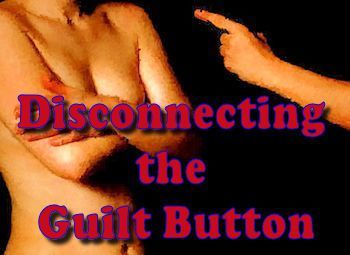
Guilt Buttons
I suppose if I have one attribute that I wouldn’t want to be without, it’s that I learned to disconnect my “guilt button.” God knows I’ve been worked on by “guilting experts,” and yet there is something going on in me that causes attempts at manipulation to run from me like water off a ducks’ back.
A few definitions.
Guilt is often the result of blame.
Self-responsibility is owning up to what I am doing, and creating for myself. Everything, after all is an inside job.
Manipulation is game playing designed to get others to change so you don’t have to.
Ben Wong & Jock McKeen, in The NEW Manual for Life, differentiate between guilt and shame. They write that guilt is always about transgressing an externally applied norm. Shame, however, is related to the feeling one gets when one realizes he or she has not been “all that they could be” in a situation.
A week or so ago, Darbella and I were out for dinner with a new friend, and the conversation came around somehow to parents and parenting. I told a couple of stories about my mom, who, as well as a ton of great attributes, was an expert at “doing guilt.”
Part of her shtick came from a profound sense of entitlement. Until the day she died, she assumed that she was so “important” that what she wanted should take precedence over the life choices of anyone else.
“How can they treat me like this?” was her shorthand for, “Don’t they know who I am?”
Growing up and watching mom do the “guilt thing” to get her way steeled me against the wiles of the guilt trap. I still remember a call I got from my mom, back when she and dad were in their 70’s. The whole point of the call, mom being in tears throughout, was to let me know that dad had finally said “no” to her. “I can’t believe it! I never thought I’d live so long! He said, ‘no!'”
I replied, “Good! I’ve been saying ‘no’ to you since I was 17. Glad he caught on!” Silence. Then, she changed the subject.
Now, of course, if the things suggested by “guilt button pushers” didn’t, at some level, make sense, they’d have no effect on us. But the logic isn’t what’s important.
This differs from a request, which goes, “Here is my preference. What do you choose?” With a request, the “requester” is OK with hearing “no,” as their self-image isn’t tied up in what someone else decides.
One woman I know is a “guilt machine.” She almost never comes up for air. She has a picture of how her kids and the men in her life “ought to” be.
She seems afraid to state her message aloud; it’s always couched in terms of books, studies, and “logic.” But were she to speak her truth, it would sound like: “I am in charge here. I know who you are, and how you should behave. Your opinion doesn’t matter. If you love me, you will always defer to me and my wishes.”
Fortunately, most of the people in her life are learning to deal with her as I learned to deal with my mom: love her, understand her games, laugh, and gently and repeatedly say, “That you want me to be a certain way is interesting. I choose to be the way that works for me. Whether you choose to hurt yourself over that or not is your choice.”
The problem with guilt and blame
My dad was good at dealing with reality — good at dealing with what was right in front of him — good at disengaging from guilt or blame.
But that doesn’t mean he didn’t have life and death challenges
Back in the late 70’s, he was working at Radio Shack, and the store got robbed. Dad would have been in his 60’s at the time. The robbers tied him up with speaker wire, threw him to the floor, and stole his wallet and engagement ring. Then they sat on his back and clicked a gun next to his ear, and threatened to kill him. They left after 15 minutes, and a customer found dad trussed up several minutes later.
Initially, dad was really pissed off at every person of the racial group of the people who had robbed him. He railed against “them,” and started using racial epithets. I listened and encouraged him to dump. After 3 months he bought me a cup of coffee and said, (actually, this is the Wayne-speak version of what he said…) “Wow. That was weird. I almost became a racist over the actions of two guys. I could have spent the rest of my life blaming and hating. Close call, eh?”
So, it was interesting, many moons later, that dad attempted to push my “guilt button.”
After my mom died in 2000, (as mom returns, in another story) we sent her body off, as per her Living Will, to the University of Toronto Medical School.
The doctors-in-training might work on a body for as long as three years. Dad chose not to hear that information.
18 months later, they finished up, cremated her remains, and left me a message that “the family” either needed to pick up the ashes, or tell them to bury them. I told dad, and he just nodded. I told him again. More nodding. A few months passed, and dad began to ask about her ashes.
I repeated what I’d told him: her ashes were at a cemetery in Toronto, and had been for some time, awaiting instructions. From him.
Dad (who didn’t want to decide) said, “This is your mother. What are you going to do about her ashes? A good son would care about his mother and fix this.”
I replied, “It’s not my mother. It’s her ashes. And the decision about the disposal is yours.”
He tried to pass the buck a couple more times, always using the “A good son, or a good daughter-in-law, would…” We resisted being “guilted” into deciding, and kept inviting him to choose another way.
Finally, after a month or so, he got real, and said, “I just can’t decide, and I would like it if you would decide for me.” We agreed, and picked up the ashes.
I suggested a place that she loved where the ashes could be scattered. He smiled. “She’d like that. She loved that place.”
For me, the difference is in the sentiment. Dad initially tried to play on my emotions. “She’s your mother, and you’re being disrespectful,” was the ploy. The message was that there is a certain way I was to act, based upon some invented societal norm.
My message, in return, was to notice, aloud, that dad was trying to use guilt to pass the buck, thus avoiding a difficult decision he didn’t want to make. It took a month, but then dad asked me to deal with it, as opposed to trying to manipulate me into taking over by pushing the “guilt button.”
I long ago learned that giving in to guilt, no matter how is it couched, creates the expectation that you’re going to give in to guilt the next time. Better to be clear and firm, and invite others into self-responsibility.
Unfortunately, emotional blackmail is rampant in our society.
Saying, “I’m emotionally upset and having difficulty deciding. Please offer your opinion,” is different from, “If you were a decent person, you’d stop being a jerk and bail me out.” The first is a self-responsible asking for help. The second is trying to manipulate through guilt.
Here’s a last, short example. I saw a couple some years back. I asked them why they had come in. Silence. I asked again. The woman sighed, and said, “I got caught cheating on my husband.”
For the rest of the session, she sat in silence. When pressed, she’d reply, “I don’t know why I did it. Everything was wonderful. He needs to move on, and not be angry.”
She was stonewalling. She was deeply in manipulation mode, and didn’t want to deal with her choices. Her message was, “Can’t you see how bad I feel? Now drop it, and move on, and let’s get this thing back to the way it was. And if you really love me, you’ll assure me that you trust me.”
Rather than be self-responsible and deal with her actions, she focussed on her husband. This was because she indeed felt guilty… over being caught, and wanted to change the subject.
Guilt is an interesting thing. It’s always linked to someone not wanting to take responsibility – to someone trying to use emotions to get someone else to fix their messes.
Think about your experiences with guilt. Do you use guilt and manipulation to get your way? Are you victimizing yourself when others use guilt with you? The way out is simple.
Self-responsibility, once again.
As always.
div.wpob_template_main.wpob_template_main_1{display: none;}
.wpob_template_main_1{
background-color: #fff;
max-width: 750px;
height: 310px;
border-width: 7px;
border-color: #ccc;
margin-top: ;
margin-bottom: ;
margin-left: ;
margin-right: ;
}
.wpob_template_main_1 .wpob_box_heading{
background-color: #8f0a0b;
}
.wpob_template_main_1 .wpob_box_heading_text{
font-family: 'Shadows Into Light', serif;
font-size: 24px;
line-height: 40px;
color: #fff;
text-align: center;
text-transform: uppercase;
font-weight: 900;
margin: 0;
}
.wpob_template_main_1 .wpob_box_media_container{
display: inline-block;
width: 120px;
height: 164px;
}
.wpob_template_main_1 .wpob_box_content_container{
}
.wpob_template_main_1 input.wpob_input_fields{
width: 200px;
line-height: 36px;
margin-bottom: 5px;
border: 1px #ddd solid;
vertical-align: middle;
font-size: 16px;
color: #999;
font-size: Arial;
padding: 0px 8px;
}
.wpob_template_main_1 .wpob_box_image{
width: 100%;
height: 100%;
}
.wpob_template_main_1 .wpob_box_media_center{
display: block;
margin: 0 auto;
padding: 10px;
}
.wpob_template_main_1 .wpob_box_media_right{
float: right;
padding: 10px 0px 10px 20px;
}
.wpob_template_main_1 .wpob_box_media_left{
float: left;
padding: 10px 20px 10px 0px;
}
.wpob_template_main_1 .wpob_box_content{
font-family: Fjalla One;
font-size: 18px;
line-height: 24px;
color: #333;
text-align: center;
padding: 1em;
}
.wpob_template_main_1 .wpob_box_button_div{
text-align: center;
padding: 0em 1em 1em 1em;
}
.wpob_template_main_1 .wpob_box_button_div a.wpob_box_button, .wpob_template_main_1 .wpob_box_button_div button.wpob_box_button{
font-family: Georgia;
font-size: 18px;
color: #fff;
background-color: #0c8442;
border-radius: 5px;
width: ;
padding: 10px 15px;
}
.wpob_button_gradient{background-image : -moz-linear-gradient(top, #0c8442, #057538);background-image : -ms-linear-gradient(top, #0c8442, #057538);background-image : -webkit-gradient(linear, #0c8442, #057538);background-image : -webkit-linear-gradient(top, #0c8442, #057538);background-image : -o-linear-gradient(top, #0c8442, #057538);background-image : linear-gradient(top, #0c8442, #057538);filter : progid:DXImageTransform.Microsoft.gradient(startColorstr="#0c8442", endColorstr="#057538", GradientType=0);border-color : +#0c8442 #057538 #057538;background-color : #0c8442;}
A Shameless Bribe!!

Receive The Pathless Path by e-mail!
As a thank-you, we'll send you a link to our pdf booklet, Exercises in Consciousness.
What could be better than that??
Cick and Join Us!
The post Disconnecting the Guilt Button appeared first on The Pathless Path.
Original article: Disconnecting the Guilt Button. If you're reading this on another site, let me know...
October 30, 2016
On Being Yourself
Synopsis: On Being Yourself–you are exactly and only who you are–including what you discover about yourself–the parts tucked away
Of Wayne’s many books, the one closest to today’s topic is: This Endless Moment

Here’s a question I received from a reader:
… I’d be interested in what you might have to say about personal limitations and failure. How do we acknowledge and accept them in a positive way? How do we act within our limits, yet reach beyond our grasp? There seems an inherent contradiction between “setting your mind on anything” and the real, universe-given limitations that we are born with. What does failure mean with respect to all of that?
First of all, people who think you can “set your mind on anything,” assume that there is equality between persons. In other words, that all persons are capable of anything. That we’re all, at some cellular level, the same.
I’ll say more about this in a minute.
Ben Wong and Jock McKeen, in their excellent book, The NEW Manual for Life, expand on Karen Horney’s observations, and posit that the process of socialization causes us to repress that which is not acceptable to those in authority over us (originally, our parents.) We create a “politically correct” persona, capable of fitting in.
We also create (using Freud’s term) a superego, which Ben and Jock call the Ideal Self.
This part of us is never satisfied with who we are, and is like a relentless, “good cop/bad cop” drill sergeant. Our Ideal Self relentlessly urges us ever onward and upward, telling us that we can do anything, be anything; indeed, if we were a decent person, we would already be doing and being more. The set-up, of course, is that we can never do and be everything our Ideal Self wants us to be and do (it’s an ideal, not a possibility).
When we fail, we fall into self-hatred. The voice of this self-hatred is also provided by the superego, which now shifts to the “bad cop” side of the drill sergeant.
“You always screw up. You’ll never amount to anything.” And then, with a sly wink, the “good cop” appears. “Unless, you try harder. You can do anything, you know, if only you’d put your mind to it.”
Missing in this dialogue with our Ideal Self are 2 things:
any sense of the here and now satisfaction of simply being alive, and
any chance at having an authentic life.
Authenticity is a rare commodity these days. Authenticity comes from an acknowledgement and sharing of the totality of our being, not just the parts we were taught to favour. And part of that acknowledgement is that we are, to drag back in my first point–emphatically–not equal.
The harpies of political correctness will at this point either excoriate me or unsubscribe.
For the rest of you still reading, let’s do some thinking. Right away, some of you are going to get what I’m saying, some are going to struggle, and some are not going to get it. That’s not about the point I’m making–that’s about how our brains work.
My point is not right, nor is it wrong. It is simply my opinion.
That you agree or disagree is about how you process the concept I’m presenting. Some people will use logic to check it, others will apply morals (rights and wrongs) to their process of analysis, some will decide that my point is not even worth considering… and others will do… whatever.
A simple demonstration, I contend, of the fact that our minds function differently, and therefore, are not equal.
It’s the same with physical attributes. I am my body, just as I am my mind, and all I have to work with is the body I have. There are things about my body that I can do something about–my weight or strength, for example–and there are things I can’t do anything about–my height, for example.
As an illustration, Dar and I are well matched in terms of endurance. We have paddled kayaks down treacherous rivers and across lakes for 12 hours, then picked up our kayaks and packs and portaged 5 km. to get to home base. Yes, we were whacked, but there was no sense that we couldn’t do it, no fear of dying in the process. We’re more like plough horses than racehorses.
This is a characteristic of our physical selves. Some people have more endurance, some less. Not equal.
Same thing emotionally. Some people are gifted with a range of emotions, and the ability to express them without blaming. Others are gifted with their entitlements and a list of whom to blame. Both are approaches to the emotional life. Both “work,” at some level. They, however, are not equal.
Political correctness has caused these differences to be hotly denied: we give everyone “participation awards” that declare the showing up is the same as excelling. We are cautioned not to offer criticism of someone’s crappy work, lest fragile egos be damaged.
This is silliness in the extreme.
We forget that there is only one equality: each of us has the ability to know ourselves and fulfill our destinies (dharma) within the bounds of who we actually are (karma.)
Life is not about comparisons to others.
I am in deep trouble if I compare myself to others. If my baseline is to be as good as or better than Joe Blow, I will be caught in comparisons that are impossible. I can’t be like Joe, as we are not equal in intelligence, wisdom, or life-experience. To compare myself (or worse, to want or demand what Joe has) is the height of arrogance and silliness and will lead nowhere I want to go.
This also means that I must (horrors!) take full responsibility for my choices, decisions and directions.
Just as there is no one to compare myself to, there is no one is to blame for any choice I have ever made. I am where I am and I know what I know based solely upon what I have chosen to learn, to absorb, to assimilate and to find within myself.
So, to answer the question I was asked,
I am here to explore myself and to unearth the totality of who I am. My goal is to come into a place of acceptance – acceptance of my skill set (as it is, not as I wish it was) my abilities (as they are, not as I wish them to be) and my self (all of me, warts and all.)
From this place of acceptance, I will, as I choose to, push the boundaries of what I know and who I am, learning to include more and more of myself–more and more of the material I blocked. I do this through dialogue with people I respect, through study, through reflection, through writing, practice and integration.
I will, above all, keep my nose firmly planted on my face and on my side of the fence, judging my successes and failures (of which there will be an abundance – of both) on the only basis that has significance – by comparison to me. I do not succeed when another fails, nor vice versa.
I choose to be in dialogue with a short list of other explorers, and continue to open myself to their stories, their insights and their views, both of their lives and of their sense of me. In that process of open-hearted revelation, I continue to allow myself to explore the depths of the only person I can ever know. Me.
I know that my self-knowledge and contentment is in direct proportion to my honest self-exploration and self-acceptance. No one, no thing, including life, owes me anything.
As in the Zen tale, tiger above me, tiger below me, I am clinging to a breaking branch on the side of a mountain. In front of me, a strawberry. I take it, and I eat. Delicious!
div.wpob_template_main.wpob_template_main_1{display: none;}
.wpob_template_main_1{
background-color: #fff;
max-width: 750px;
height: 310px;
border-width: 7px;
border-color: #ccc;
margin-top: ;
margin-bottom: ;
margin-left: ;
margin-right: ;
}
.wpob_template_main_1 .wpob_box_heading{
background-color: #8f0a0b;
}
.wpob_template_main_1 .wpob_box_heading_text{
font-family: 'Shadows Into Light', serif;
font-size: 24px;
line-height: 40px;
color: #fff;
text-align: center;
text-transform: uppercase;
font-weight: 900;
margin: 0;
}
.wpob_template_main_1 .wpob_box_media_container{
display: inline-block;
width: 120px;
height: 164px;
}
.wpob_template_main_1 .wpob_box_content_container{
}
.wpob_template_main_1 input.wpob_input_fields{
width: 200px;
line-height: 36px;
margin-bottom: 5px;
border: 1px #ddd solid;
vertical-align: middle;
font-size: 16px;
color: #999;
font-size: Arial;
padding: 0px 8px;
}
.wpob_template_main_1 .wpob_box_image{
width: 100%;
height: 100%;
}
.wpob_template_main_1 .wpob_box_media_center{
display: block;
margin: 0 auto;
padding: 10px;
}
.wpob_template_main_1 .wpob_box_media_right{
float: right;
padding: 10px 0px 10px 20px;
}
.wpob_template_main_1 .wpob_box_media_left{
float: left;
padding: 10px 20px 10px 0px;
}
.wpob_template_main_1 .wpob_box_content{
font-family: Fjalla One;
font-size: 18px;
line-height: 24px;
color: #333;
text-align: center;
padding: 1em;
}
.wpob_template_main_1 .wpob_box_button_div{
text-align: center;
padding: 0em 1em 1em 1em;
}
.wpob_template_main_1 .wpob_box_button_div a.wpob_box_button, .wpob_template_main_1 .wpob_box_button_div button.wpob_box_button{
font-family: Georgia;
font-size: 18px;
color: #fff;
background-color: #0c8442;
border-radius: 5px;
width: ;
padding: 10px 15px;
}
.wpob_button_gradient{background-image : -moz-linear-gradient(top, #0c8442, #057538);background-image : -ms-linear-gradient(top, #0c8442, #057538);background-image : -webkit-gradient(linear, #0c8442, #057538);background-image : -webkit-linear-gradient(top, #0c8442, #057538);background-image : -o-linear-gradient(top, #0c8442, #057538);background-image : linear-gradient(top, #0c8442, #057538);filter : progid:DXImageTransform.Microsoft.gradient(startColorstr="#0c8442", endColorstr="#057538", GradientType=0);border-color : +#0c8442 #057538 #057538;background-color : #0c8442;}
A Shameless Bribe!!

Receive The Pathless Path by e-mail!
As a thank-you, we'll send you a link to our pdf booklet, Exercises in Consciousness.
What could be better than that??
Cick and Join Us!
The post On Being Yourself appeared first on The Pathless Path.
Original article: On Being Yourself. If you're reading this on another site, let me know...
October 22, 2016
The Myth of a Soul Mate
This is post 8 of 8 in the series “The Myths Series”
Synopsis: The Myth of a Soul Mate — soul mate thinking is one-sided thinking. Better to find a mirror.
Of Wayne’s many books, the one closest to today’s topic is: This Endless Moment

I’m going to be semi-quick with this one.
People have heard the “one perfect person for me” crap forever–it’s a major movie and book theme, after all–so they frantically run around trying to find this mythic being.
There’s a flaw to this idea, however.
I’ve heard various “takes” on this theme — people describing what they are looking for in a “soul mate” — and every time, what’s actually being said is something I call “placeholder theory.”
This theory is: “I was late for a meeting, so I (prayed, made an affirmation, etc.) and I drove into the parking lot, and just as I did, someone pulled out!”
That person in the waiting car is what I call a “placeholder.”
Because the story-teller is so important, the other person’s only job is to “wait”… to hold a place for this special, special person. Oddly, when I suggest to said special person that they too must have been a placeholder for another, “stronger” person, they get right annoyed with me. “Me? A placeholder? That would be… wrong!”
No kidding.
When it comes to soul mate language, if you listen carefully, you’ll discover that the person sought isn’t someone “just perfect,” nor “just right.” The person being sought is “Someone who will do exactly what I want and be exactly who I want them to be.” In other words, it’s Peter Pan looking for Wendy. Or vice versa.
A servant, if you will. A foil.
This is not to say that we shouldn’t seek compatibility when engaged in mate-picking. The List of 50, a tool in my book, Find Your Perfect Partner, is all about this. When you do your list responsibly and without short-cuts, you discover that many people are a fit your temperament and nature. I guess 5% of the population will fit, once you actually know what you are looking for.
That being said, after you’ve found a “compatibility fit,” the real work of communication and intimacy begins. You can read about that in The. Best. Relationship. Ever.
Not so with the soul mate as described above. That’s not relationship – that’s manipulation.

I knew a woman back in Seminary–when I first met her, she was married to a psychiatrist. She later told me (using “perfect partner” language) that she’d initially been attracted by his good looks, and then by how smart he was. She was excited, as she thought she was really smart — they could actually discuss stuff!
The marriage lasted less then 6 months. Why did it end? “He argues with me. He was supposed to support me and make me feel good about myself!”
She started telling me that she wanted to find a husband like me: I’d laugh and shake my head, because every time I challenged her — and I do challenge my friends — she’d piss herself right off, and stop talking to me to punish me. I found the silence refreshing.
The next summer she got a job at a camp, and in short order auditioned the entire male staff, looking for her soul mate. None suited her — none were, she told me, suitably compliant and interested in being her soul mate.
But she didn’t give up. She got to the last guy in the string, on the last few days of her job. He was perfect, she told me. “He listens to me! He tells me I’m doing great! He praises me endlessly! He’s perfect!”
A few years later she showed up on my doorstep, teary-eyed. She’d filed for divorce. Why? “He never has an opinion! All he does is agree with me! He never calls me on my shit!”
I just smiled.
You see, her version of “male soulmate” is: Does what I want. Builds me up. Agrees with me. Praises me as the smartest person in the room. Endlessly. And without reciprocity on my part.
We’d suggest that the actual purpose of being in relationship is to be with a person who provides a “talking mirror” for what you are doing. Not judgement, not a critique, just “feedback.” And key to this: you provide this mirroring to your partner, same parameters.
No demand for cheer-leading, no “Aren’t you just the most special thing?” Feedback. Compassion. Caring. In dialogue.
As we’ve endlessly said, if your relationships never seem to last, have a look at yourself and your balance.
You only get what you are willing to give. There are no “special people” in elegant relationships. Partners are not there to make you feel better about yourself, or to do your bidding. True, elegant partners witness both our wholeness and our fragmented-ness — not to fix us, but simply to be a witness. And vice versa.
Thus, the only “soul mate” I want is one who agrees that we’ll work on ourselves first, and will do so through intimate dialogue with each other. We’ll remain curious about each other, without trying to change the other or control the other, and especially without becoming dependent on the other. My partner is, above all, my equal.
And her name is Darbella.
Are we “soul mates?” Nah. Intimate partners, engaged in intra-personal growth through dialogue. Of course! For 34 years, of course!
This week, have a look at what you are looking for, or expecting, from your principal relationship. See if you can hold your ego in check long enough to really go for the depth.
div.wpob_template_main.wpob_template_main_1{display: none;}
.wpob_template_main_1{
background-color: #fff;
max-width: 750px;
height: 310px;
border-width: 7px;
border-color: #ccc;
margin-top: ;
margin-bottom: ;
margin-left: ;
margin-right: ;
}
.wpob_template_main_1 .wpob_box_heading{
background-color: #8f0a0b;
}
.wpob_template_main_1 .wpob_box_heading_text{
font-family: 'Shadows Into Light', serif;
font-size: 24px;
line-height: 40px;
color: #fff;
text-align: center;
text-transform: uppercase;
font-weight: 900;
margin: 0;
}
.wpob_template_main_1 .wpob_box_media_container{
display: inline-block;
width: 120px;
height: 164px;
}
.wpob_template_main_1 .wpob_box_content_container{
}
.wpob_template_main_1 input.wpob_input_fields{
width: 200px;
line-height: 36px;
margin-bottom: 5px;
border: 1px #ddd solid;
vertical-align: middle;
font-size: 16px;
color: #999;
font-size: Arial;
padding: 0px 8px;
}
.wpob_template_main_1 .wpob_box_image{
width: 100%;
height: 100%;
}
.wpob_template_main_1 .wpob_box_media_center{
display: block;
margin: 0 auto;
padding: 10px;
}
.wpob_template_main_1 .wpob_box_media_right{
float: right;
padding: 10px 0px 10px 20px;
}
.wpob_template_main_1 .wpob_box_media_left{
float: left;
padding: 10px 20px 10px 0px;
}
.wpob_template_main_1 .wpob_box_content{
font-family: Fjalla One;
font-size: 18px;
line-height: 24px;
color: #333;
text-align: center;
padding: 1em;
}
.wpob_template_main_1 .wpob_box_button_div{
text-align: center;
padding: 0em 1em 1em 1em;
}
.wpob_template_main_1 .wpob_box_button_div a.wpob_box_button, .wpob_template_main_1 .wpob_box_button_div button.wpob_box_button{
font-family: Georgia;
font-size: 18px;
color: #fff;
background-color: #0c8442;
border-radius: 5px;
width: ;
padding: 10px 15px;
}
.wpob_button_gradient{background-image : -moz-linear-gradient(top, #0c8442, #057538);background-image : -ms-linear-gradient(top, #0c8442, #057538);background-image : -webkit-gradient(linear, #0c8442, #057538);background-image : -webkit-linear-gradient(top, #0c8442, #057538);background-image : -o-linear-gradient(top, #0c8442, #057538);background-image : linear-gradient(top, #0c8442, #057538);filter : progid:DXImageTransform.Microsoft.gradient(startColorstr="#0c8442", endColorstr="#057538", GradientType=0);border-color : +#0c8442 #057538 #057538;background-color : #0c8442;}
A Shameless Bribe!!

Receive The Pathless Path by e-mail!
As a thank-you, we'll send you a link to our pdf booklet, Exercises in Consciousness.
What could be better than that??
Cick and Join Us!
The post The Myth of a Soul Mate appeared first on The Pathless Path.
Original article: The Myth of a Soul Mate. If you're reading this on another site, let me know...
October 15, 2016
The Myth of Scarcity
Synopsis: The Myth of Scarcity–when people claim something is missing in their lives, they usually mean that no one told them they’d have to work and sacrifice for it.
Of Wayne’s many books, the one closest to today’s topic is: This Endless Moment
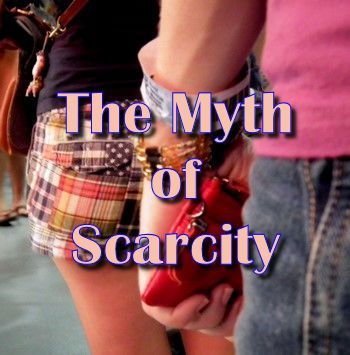
It’s not worth standing in line for…
Scarcity? Why, a little self-responsibility goes a long way.
A couple of weeks back, our niece got married. We flew back to Ontario for the nuptials. Got to spend time with her and her brother (otherwise know as our nephew) and their respective families. You know, they’ve turned out OK!
Back when they were kids and young teens, they set money aside for the things they wanted. Then… wait for it… they bought the things they wanted with money they earned; they have always taken care of themselves. Still are.
Quite unusual; most kids / teens I know assume that mom and dad are actually ATMs.
Said teens sit on their butts and expect their parents to give them whatever they want. They learned this behaviour as kids–they were given the stuff they wanted. Why? Parental guilt, mostly, plus some weird idea that this somehow helps the kid.
Besides, standing up to the endless requests that come with childhood is “hard” (sob, sniffle.)
This starts when the is kid screaming in the candy line–and the parent buys the candy to get the kid to shut up. The parent’s choice to endlessly buy a moment’s silence contributes to producing a person who thinks they’ll get what they want by simply wanting it. And if simply wanting it isn’t enough, then they’ll whine. And if whining isn’t enough, they’ll pitch a fit, and wail that “It isn’t fair!” that they can’t have what they want.
If that doesn’t work, they’ll try to grab what they want from another. And if that doesn’t work, they’ll turn into Trump, try to get elected President, and make the meeting of their wants public policy.
Such people think that not having things they didn’t earn demonstrates something external: a shortage, an unfairness, an unequal distribution of wealth–a scarcity. Of whatever.
Here’s a hint – there is no scarcity of things–there is a scarcity of self-responsibility and motivation.
Most couples that seek relationship counselling declare that there is a scarcity of intimacy in their relationship. (Of course, they don’t use those words–it’s what they mean, though.) They then, loudly and at great length, describe what their partner has to do in order for there to be more intimacy. Each feels that the other person should change. They also want their partner to stop insisting that they change–because–hey! it’s entirely the other person’s fault!
“If you loved me you’d change. You’d stop doing all the things I don’t like, and you’d stop criticizing me and accept me as I am.”
And then the other person says some version of the same thing. Never mind that this approach has never worked for them–not once. Never mind that what they are asking for is a relationship that doesn’t cost them anything.
No, they declare, indignantly, they are being deprived of their just due because of the selfishness of their partner.

I remember once working with a woman who wanted to be an artist. She got her husband to build her a 1200-foot studio. She never completed any projects, because she was afraid publishers wouldn’t like her work. (She was illustrating the children’s’ books she’d written.) She couldn’t understand why no one would just give her money, sight unseen, for her uncompleted work. (Entitlement # 1)
Then, she fell in lust with the carpenter who built the addition. This is when she came to see me. She was entitled, (entitlement # 2) she told me, to a deep and meaningful relationship with the carpenter (who was also married) and was entitled (# 3) to have the permission and blessing of her husband, the carpenter’s wife (# 4) and all their kids (# 5), while at the same time staying with her husband (# 6) and having him pay all the bills! (# 7) Because, you know, she wanted (# 8) this relationship, and it was good for her (# 9), and people should understand (# 10).
I said that she could ask for all of this, but she needed to be ready for her husband to scream “NO!” as the door hit her on the backside (Reality 101). She patiently explained to me that this would not happen, because God wanted her to have this relationship (entitlement from God) — and who was I to try to trump God?
What she wanted from me (entitlement of the “self-declared “wise” – what she wanted was for me to do and say what she wanted me to do and say. “I need help and don’t know what to do. My life is a mess. Here is what you should say to help me.”) was to help her get her affirmation just right, so that she’d get what she wanted.
She claimed, loud and clear, that she didn’t have a relationship problem–she had a faulty affirmation. (I’d never heard a brain called an affirmation before, but I digress.) I fired her.
From what I heard through the gossip mill, both marriages disintegrated, the lusting couple aren’t speaking and the studio is empty. But boy, she was entitled to everything — everything she got.
You can’t have something just because you want it. No, life costs. Relationships cost. They need a full-bodied commitment, 24 hours a day, 7 days a week. The price is commitment. It’s not lying to yourself, manipulating people, running around half cocked. Abundance is there, not for the taking, but for the earning.
We can have anything we are willing to pay for, in time, talent, effort and money.
What there isn’t is a free ride.
div.wpob_template_main.wpob_template_main_1{display: none;}
.wpob_template_main_1{
background-color: #fff;
max-width: 750px;
height: 310px;
border-width: 7px;
border-color: #ccc;
margin-top: ;
margin-bottom: ;
margin-left: ;
margin-right: ;
}
.wpob_template_main_1 .wpob_box_heading{
background-color: #8f0a0b;
}
.wpob_template_main_1 .wpob_box_heading_text{
font-family: 'Shadows Into Light', serif;
font-size: 24px;
line-height: 40px;
color: #fff;
text-align: center;
text-transform: uppercase;
font-weight: 900;
margin: 0;
}
.wpob_template_main_1 .wpob_box_media_container{
display: inline-block;
width: 120px;
height: 164px;
}
.wpob_template_main_1 .wpob_box_content_container{
}
.wpob_template_main_1 input.wpob_input_fields{
width: 200px;
line-height: 36px;
margin-bottom: 5px;
border: 1px #ddd solid;
vertical-align: middle;
font-size: 16px;
color: #999;
font-size: Arial;
padding: 0px 8px;
}
.wpob_template_main_1 .wpob_box_image{
width: 100%;
height: 100%;
}
.wpob_template_main_1 .wpob_box_media_center{
display: block;
margin: 0 auto;
padding: 10px;
}
.wpob_template_main_1 .wpob_box_media_right{
float: right;
padding: 10px 0px 10px 20px;
}
.wpob_template_main_1 .wpob_box_media_left{
float: left;
padding: 10px 20px 10px 0px;
}
.wpob_template_main_1 .wpob_box_content{
font-family: Fjalla One;
font-size: 18px;
line-height: 24px;
color: #333;
text-align: center;
padding: 1em;
}
.wpob_template_main_1 .wpob_box_button_div{
text-align: center;
padding: 0em 1em 1em 1em;
}
.wpob_template_main_1 .wpob_box_button_div a.wpob_box_button, .wpob_template_main_1 .wpob_box_button_div button.wpob_box_button{
font-family: Georgia;
font-size: 18px;
color: #fff;
background-color: #0c8442;
border-radius: 5px;
width: ;
padding: 10px 15px;
}
.wpob_button_gradient{background-image : -moz-linear-gradient(top, #0c8442, #057538);background-image : -ms-linear-gradient(top, #0c8442, #057538);background-image : -webkit-gradient(linear, #0c8442, #057538);background-image : -webkit-linear-gradient(top, #0c8442, #057538);background-image : -o-linear-gradient(top, #0c8442, #057538);background-image : linear-gradient(top, #0c8442, #057538);filter : progid:DXImageTransform.Microsoft.gradient(startColorstr="#0c8442", endColorstr="#057538", GradientType=0);border-color : +#0c8442 #057538 #057538;background-color : #0c8442;}
A Shameless Bribe!!

Receive The Pathless Path by e-mail!
As a thank-you, we'll send you a link to our pdf booklet, Exercises in Consciousness.
What could be better than that??
Cick and Join Us!
The post The Myth of Scarcity appeared first on The Pathless Path.
Original article: The Myth of Scarcity. If you're reading this on another site, let me know...
October 8, 2016
The Myth of Right and Wrong
This is post 7 of 7 in the series “The Myths Series”
Synopsis: The Myth of Right and Wrong–there are always exceptions to each “rule,” and making a list isn’t particularly helpful
Of Wayne’s many books, the one closest to today’s topic is: This Endless Moment

I suspect that, when most people say, “That’s wrong!” they mean “I wouldn’t do that!” — that they’d be scared to do…whatever.
The reason for this is how we learn “right” from “wrong.”
Being a child means having an almost instant feedback loop, otherwise known as parents. When we were kids, doing “wrong” got us punished, and doing “right” got us some form of reward. As adults, we still sorta expect this kind of feedback, even if we dread it.
In fact, many people get married hoping to be parented, or to parent, their spouses. And it’s quite funny how the focus of such folk is always external — on their partner — as opposed to self-reflective. But back, briefly, to parenting.
The funny thing is, the vast majority of things declared by our parents and tribes to be “right” or “wrong” are simply their personal preferences. For example, one woman I worked with decades ago grew up in a one-parent household. Her dad left when she was a kid. Her mom never got over this.
On a regular basis, mom would say, “Men can’t be trusted. Every man will hurt and abandon you.”
Now, guess what my client believed? This mom-mantra became a “rule.” A “truth.”
And indeed, every man she picked cheated on her, and then left her. She fervently believed that “this was the way it is.” Because of her conditioning, she got what she expected. Thing is, there’s no “right” or “wrong” about it.
Secondarily, there’s the whole issue (discussed at length in Ben Wong & Jock McKeen’s The NEW Manual for Life) of the repression of the authentic self that is a part of all human conditioning.
Babies come into the world as a bundle of potentiality. Each child has a unique set of ways of being and doing, and of all of that “stuff” will come under pressure. In other words, this authentic self, this complete self, will be sliced and diced by what I call in my book This Endless Moment the T&C (our tribes and culture.)
Parts of us (our skills, characteristics, and characters) will be approved of, and other parts will be rejected. The parts that are rejected go background, and agitate and mess with us from what Jung called The Shadow.
An acquaintance of ours remembers having a deeply artistic bent when she was a kid. Her parents were in the sciences, and, using all kinds of manipulations, kept reinforcing the idea that “In our family, we don’t make art, we donate to the arts” and “Painting is not a career.” Around age 8 they took all of her art supplies away, and refused to buy her more. She stopped all forms of painting and art.
They made art “wrong,” and had the power to enforce their belief. Her artist finally went background. Mom and dad continued to stress the sciences as the only “right” career.
In her teens, she rebelled, but in a typically teen way. She didn’t go back and examine her parents’ assumptions — she had bought into their belief system, and declared, “I’m not an artist” and “Being an artist is bad.” What she did do was become sexually active at 14, and she dropped out of High School at 16, ending the whole “scientist” thing. She became a secretary. She figured, “That’ll show them!”
Of course, she really only hurt herself, and totally missed what had been going on.

Ten years went by. During that time she painted three paintings. She hid them in the closet in her room. I saw one, one day — it was a depiction of three people in a very hot clinch. We started talking about art. Over time, her story came out. With much effort, she let go of the art / science, “bad” / “good” nonsense, finished High School, and enrolled in a University Arts program.
But there’s more to the story.
T&C (often in the guise of parents) doesn’t stop pressuring for compliance when we become teens. All that changes is the “maturity” of the topics. When my friend became a teen, mom and dad started criticizing her appearance, clothes choices, and her body. When puberty hit, her mother spoke to her about how sex was “bad,” — something to be put up with and gotten past.
Both messages “went in,” with different expressions:
In my opinion she was quite attractive and well-proportioned. She needed to paint a self-portrait for Art Class, and I shot a portrait series for her. Lovely photos. Then I saw her sketches: she drew herself as old, ugly and fat. Because she had earned to believe that her that her body was “wrong.”
Although sexually active since 14, she doesn’t enjoy sex. She called it, “Going through the motions.”
Her best paintings are quite erotic, and as soon as she paints one, she does a mental “Bad girl!!!” and the next dozen or so are pap.
Each of her beliefs — her “good and bad list” — come from her formative years — and it is so for all of us.
As we get older, we do change some of the items on our “good” / “bad” list, but the hard part is getting people to buy the idea of doing away with lists entirely. The problem with lists is that they let people off the hook — from moment-by-moment, issue by issue thinking.
And that’s too bad, because all people, given encouragement (notice that word en-courage-ment) have the ability to make ethical and behavioural choices situationally, and on the fly.
Since we met, Darbella and I have been experimenting with a radical idea. It’s simple. If something comes up and it has a knee-jerk “right / wrong” label attached, we explore it. If something scares us, we tend to do it. (see caveats, below.) And, if something interests us, we give it a shot.
This decision means that we are better able to spot any “right / wrong rules” we might have. We then examine the rule and see if it actually makes sense.
Besides, if we decide to do something despite our fear of it, will the sky fall in? Better, we think, to actually find out through our own experience than to stop ourselves based upon someone else’s opinion.
Because in the main, the things we have the strongest reaction to tend to be the oldest, and therefore taught to us by T&C. T&C had an agenda back then, and we forget that at our peril.
Which is not to say, and here’s the caveat, that I’m going to try Russian roulette. I also have opted out of bungee jumping. Not because someone else told me to, but because my fear-level is sufficient to not need to test these things.
On the other hand, discovering and exploring the pieces of my authentic self — the parts of me that my parents taught me to put away, actually liking and using and training my body — well, that’s a different story.
ake a look at the things about yourself that you declare to be “bad.” Are they really “bad,” or did they just fly in the face of what your tribe wanted of you? Explore what you judge to be “wrong” about others. Same criteria. Is it “wrong,” or just different? (This is especially true of cultural judgements, aka racism. Almost all of it is “just different.”
And lastly, look at those actions and acts you think might be fun — no — wait! you just know are “wrong!!!!” Why? What would it be like, with a clear heart and total honesty, to give one or two a chance? Then decide if you want to repeat the experience.
Because, speaking for me, I don’t want to be lying on my death-bed with a ton of regrets.
If it’s scary, chargy, or new, just do it.
div.wpob_template_main.wpob_template_main_1{display: none;}
.wpob_template_main_1{
background-color: #fff;
max-width: 750px;
height: 310px;
border-width: 7px;
border-color: #ccc;
margin-top: ;
margin-bottom: ;
margin-left: ;
margin-right: ;
}
.wpob_template_main_1 .wpob_box_heading{
background-color: #8f0a0b;
}
.wpob_template_main_1 .wpob_box_heading_text{
font-family: 'Shadows Into Light', serif;
font-size: 24px;
line-height: 40px;
color: #fff;
text-align: center;
text-transform: uppercase;
font-weight: 900;
margin: 0;
}
.wpob_template_main_1 .wpob_box_media_container{
display: inline-block;
width: 120px;
height: 164px;
}
.wpob_template_main_1 .wpob_box_content_container{
}
.wpob_template_main_1 input.wpob_input_fields{
width: 200px;
line-height: 36px;
margin-bottom: 5px;
border: 1px #ddd solid;
vertical-align: middle;
font-size: 16px;
color: #999;
font-size: Arial;
padding: 0px 8px;
}
.wpob_template_main_1 .wpob_box_image{
width: 100%;
height: 100%;
}
.wpob_template_main_1 .wpob_box_media_center{
display: block;
margin: 0 auto;
padding: 10px;
}
.wpob_template_main_1 .wpob_box_media_right{
float: right;
padding: 10px 0px 10px 20px;
}
.wpob_template_main_1 .wpob_box_media_left{
float: left;
padding: 10px 20px 10px 0px;
}
.wpob_template_main_1 .wpob_box_content{
font-family: Fjalla One;
font-size: 18px;
line-height: 24px;
color: #333;
text-align: center;
padding: 1em;
}
.wpob_template_main_1 .wpob_box_button_div{
text-align: center;
padding: 0em 1em 1em 1em;
}
.wpob_template_main_1 .wpob_box_button_div a.wpob_box_button, .wpob_template_main_1 .wpob_box_button_div button.wpob_box_button{
font-family: Georgia;
font-size: 18px;
color: #fff;
background-color: #0c8442;
border-radius: 5px;
width: ;
padding: 10px 15px;
}
.wpob_button_gradient{background-image : -moz-linear-gradient(top, #0c8442, #057538);background-image : -ms-linear-gradient(top, #0c8442, #057538);background-image : -webkit-gradient(linear, #0c8442, #057538);background-image : -webkit-linear-gradient(top, #0c8442, #057538);background-image : -o-linear-gradient(top, #0c8442, #057538);background-image : linear-gradient(top, #0c8442, #057538);filter : progid:DXImageTransform.Microsoft.gradient(startColorstr="#0c8442", endColorstr="#057538", GradientType=0);border-color : +#0c8442 #057538 #057538;background-color : #0c8442;}
A Shameless Bribe!!

Receive The Pathless Path by e-mail!
As a thank-you, we'll send you a link to our pdf booklet, Exercises in Consciousness.
What could be better than that??
Cick and Join Us!
The post The Myth of Right and Wrong appeared first on The Pathless Path.
Original article: The Myth of Right and Wrong. If you're reading this on another site, let me know...



